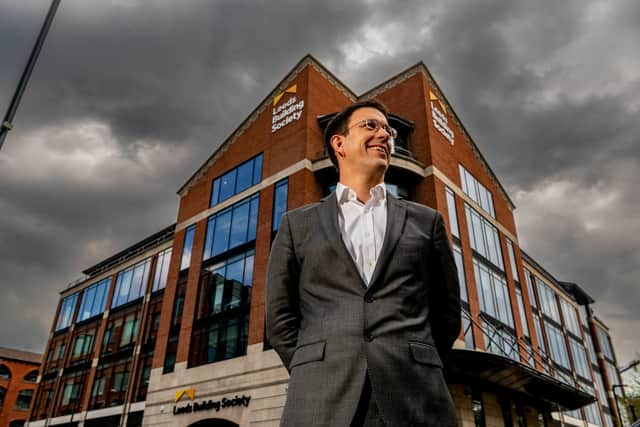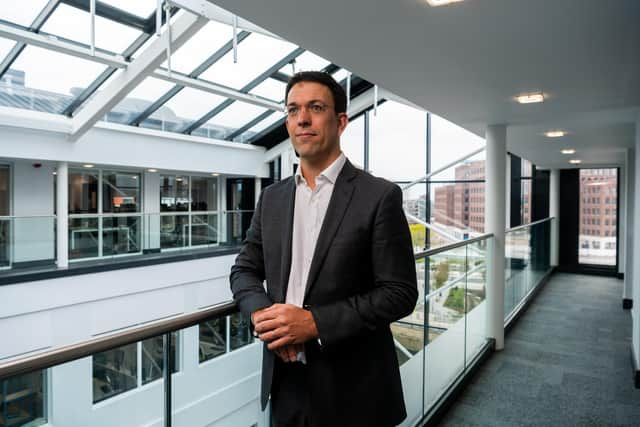Inside Leeds Building Society's record year: How scrapping second homes lending is paying off
It has been a tough few decades for the nation’s building societies as the demutualisations and mergers of the 1980s and 90s were followed by the 2008 financial crisis further reducing their numbers.
For the 43 that still survive – down from more than 1,700 in their early 20th century heyday – moving with the times while still fulfilling their historic purpose is paramount.
Advertisement
Hide AdAdvertisement
Hide AdMeeting that twin challenge has been embraced by Richard Fearon, chief executive of Leeds Building Society, which was founded all the way back in 1875 to help local people buy a home.


With house prices now at their most unaffordable level relative to incomes in the 148 years since the society has been operating, it has taken a series of innovative measures designed to help fulfil that original purpose.
This week has seen the launch of a new partnership with Experian to allow subscriptions to streaming services like Netflix and Spotify count towards credit scores in mortgage applications, while last year LBS caused a stir by announcing it would no longer lend for purchases of second homes.
That market had been worth millions to the society but represented it following through with its simplified new mission statement designed to guide all decision-making, “putting home ownership within reach of more people, generation after generation”.
Advertisement
Hide AdAdvertisement
Hide AdThe society subsequently posted record £220m profits for 2022 as they helped almost 18,000 first-time buyers.


Sitting down with The Yorkshire Post after providing a tour of the society’s highly-impressive Sovereign Street offices in Leeds’s financial sector, Fearon explains that the second homes decision last summer flowed naturally from a process to “refresh our purpose” that started in late 2021.
He says: “I say refresh because it has always been our purpose since we were founded. It was just about a really clean, simple articulation of that. We rolled it out to all 1,600 colleagues. As part of that, we asked what should we do that is different and new and what it is we do that conflicts with this? The second homes point came out loud and clear.
“It came from colleagues saying this is something that conflicts with our purpose. It cost us money but there is the saying, it is not a principle until it costs you money. We wanted to make sure that our actions matched our words. I think that if we can direct our energy to helping first-time buyers as a result of that we will be more successful in future.”
Advertisement
Hide AdAdvertisement
Hide AdHe says the move immediately began paying dividends in some unexpected ways.
“When we announced it, we had a bit of coverage and I went on Radio 4. Instantly off the back of that we had people moving their savings to us. People listened to the radio coverage and said, ‘that’s an organisation I want to be with’. It wasn’t necessarily even people who were first-time buyers themselves but whose children and grandchildren might be.
“I had about six or seven emails within a day or two from the branch network saying someone had come in and moved a £40,000 ISA to us because of it.”
Fearon joined Leeds Building Society in 2016 as chief commercial officer, becoming the CEO in 2019. He had previously been in the banking sector, working for HBOS and then Lloyds. Having lived in Yorkshire since 2009 and started a family here, Fearon says joining the society was an ideal move.
Advertisement
Hide AdAdvertisement
Hide Ad“I knew I was going to stay in Yorkshire for the rest of my career and I wanted to be part of an organisation that had its roots in Yorkshire. When I looked into it, this was the organisation I wanted to join. The culture here is so friendly and welcoming but also people really push themselves and are really focused on making a difference.”
He says watching the financial crisis play out in the early stage of his career has led to a prudent approach to risk management.
"I worked at HBOS during the last financial crisis. We’ve got a lot of banking experience on the board here. It is invaluable to have seen some of the mistakes that were made back in 2008 and before that. We have to make sure we learn from that and run a really well-capitalised, highly-liquid, very prudent and also successful business. The Banker magazine does something every year and we feature as one of the top 10 most highly-capitalised building societies in the world and that is something I am very keen we maintain.”
While the property market has been squeezed by interest rate rises, Fearon says the society has had an extremely promising start to 2023, with several record days for mortgage lending.
Advertisement
Hide AdAdvertisement
Hide Ad“Last year for me the highlight was helping 18,000 buyers into a home. The market is a lot smaller this year, so residential property is 33 per cent smaller but we are challenging ourselves to match the performance of last year. That’s a pretty tough target but we think we can get there.
“We would like to help as many first-time buyers as we did last year. We had a great start to the year, on savings we are absolutely flying. It was a record year last year and we’re well ahead of that this year. Our strategy is working.”
Investment in technology means Leeds Building Society is now able to to get a mortgage application to offer in under 30 seconds – far quicker than the market average of 15 days. But they have also retained their traditional branch network across the country and are considering expanding it, while also evolving how the buildings are used.
Fearon explains: “On the one hand, particularly in the mortgage market it is a technology business and in fact about a fifth of our colleagues work in technology or change. But particularly when it comes to savers, our branch network is tremendously important.
Advertisement
Hide AdAdvertisement
Hide Ad“What we did during the pandemic with branches secured their future totally. As well as dealing with customers face to face, they can take calls and act as mini contact centres. They can also do some of the back office processing and paperwork. It is a fantastic resource.
“Fundamentally because a lot of the bigger banks are closing branches, there are people that want face-to-face service right on the high street and we are catering really well for that market. With our savings performance, if you walk into a Leeds Building Society branch you can get a really competitive rate, personal service and an appointment that day. It is a rare combination.”
Fearon is talking to The Yorkshire Post on a busy Wednesday afternoon at the society’s headquarters, a building which was the previous home of law firm Addleshaw Goddard. In keeping with its approach to evolving with the times, staff are only required to come in for eight days a month and can work the rest of the time from home. Fearon says the move has proved popular, with many opting to come in more frequently.
The society owns the building and made a series of eco-friendly and energy efficiency improvements to make it net carbon neutral before staff arrived in 2021. Changes included refitting all the windows – with the old ones then turned into new worktops in the site. It is all part of ongoing efforts for the company to reach net zero by 2030.
Advertisement
Hide AdAdvertisement
Hide AdFearon says having a clear strategy and a “distinct point of view” is the foundation to ensuring success and remaining relevant.
“I think there is a huge overlap between what young people care about and what a building society can offer but there is a big awareness gap. So we’ve got to offer great products that are accessible through digital channels as well as in branch. I’m confident we are very well placed to stay relevant well into the future.”